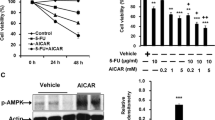Abstract
This study investigated the anticancer effects of embelin in human gastric cancer cells and the underlying molecular mechanisms. Gastric cancer cells were treated with embelin and 5-FU for methyl-thiazolyl-tetrazolium bromide cell viability assay and flow cytometric detection of cell viability and apoptosis. Protein pathway array (PPA) and Western blot were used to investigate differentially expressed proteins in embelin-treated gastric cancer cells. Embelin reduced gastric cancer cell viability, induced apoptosis, and enhanced 5-FU antitumor activity in gastric cancer cells. Mechanistically, embelin induced cell cycle arrest at the S and G2/M phases. Molecularly, embelin downregulated expression of X-linked inhibitor of apoptosis and cell cycle-regulatory proteins, such as CDK1, CDC25B, CDC25C, cyclinB1, and CDK2. PPA analysis showed that embelin modulated several pathways that are associated with cell growth and apoptosis, such as PI3K/AKT, JAK/STAT, p38 MAPK, and p53. The data from the current study implied that reduction of gastric cancer cell viability after treatment with embelin was through cell cycle arrest at the S and G2/M phases and apoptosis.







Similar content being viewed by others
References
Hohenberger P, Gretschel S (2003) Gastric cancer. Lancet 26:305–315
Yu GZ, Chen Y, Wang JJ (2009) Overexpression of Grb2/HER2 signaling in Chinese gastric cancer: their relationship with clinicopathological parameters and prognostic significance. J Cancer Res Clin Oncol 135:1331–1339
Ooi CH, Ivanova T, Wu J, Lee M, Tan IB, Tao J, Ward L, Koo JH, Gopalakrishnan V, Zhu Y, Cheng LL, Lee J et al (2009) Oncogenic pathway combinations predict clinical prognosis in gastric cancer. PLoS Genet 5:e1000676
Fang JS, Gillies RD, Gatenby RA (2008) Adaptation to hypoxia and acidosis in carcinogenesis and tumor progression. Semin Cancer Biol 18:330–337
Choi JH, Lim HY, Joo HJ, Kim HS, Yi JW, Kim HC, Cho YK, Kim MW, Lee KB (2002) Expression of multidrug resistance-associated protein1, P-glycoprotein, and thymidylate synthase in gastric cancer patients treated with 5-fluorouracil and doxorubicin-based adjuvant chemotherapy after curative resection. Br J Cancer 20(86):1578–1585
Suzuki Y, Imai Y, Nakayama H, Takahashi K, Takio K, Takahashi R (2001) A serine protease, HtrA2, is released from the mitochondria and interacts with XIAP, inducing cell death. Mol Cell 8:613–621
Notarbartolo M, Cervello M, Poma P, Dusonchet L, Meli M, D’Alessandro N (2004) Expression of the IAPs in multidrug resistant tumor cells. Oncol Rep 11:133–136
Nikolovska-Coleska Z, Xu L, Hu Z, Tomita Y, Li P, Roller PP, Wang R, Fang X, Guo R, Zhang M, Lippman ME, Yang D et al (2004) Discovery of embelin as a cell-permeable, small-molecular weight inhibitor of XIAP through structure-based computational screening of a traditional herbal medicine three-dimensional structure database. J Med Chem 47:2430–2440
Podolak I, Galanty A, Janeczko Z (2005) Cytotoxic activity of embelin from lysimachia punctata. Fitoterapia 76:333–335
Siegelin MD, Gaiser T, Siegelin Y (2009) The XIAP inhibitor embelin enhances TRAIL-mediated apoptosis in malignant glioma cells by down-regulation of the short isoform of FLIP. Neurochem Int 55:423–430
Mori T, Doi R, Kida A, Nagai K, Kami K, Ito D, Toyoda E, Kawaguchi Y, Uemoto S (2007) Effect of the XIAP inhibitor embelin on TRAIL-induced apoptosis of pancreatic cancer cells. J Surg Res 142:281–286
Salvesen GS, Duckett CS (2002) IAP proteins: blocking the road to death’s door. Nat Rev Mol Cell Biol 3:401–410
Srinivasula SM, Ashwell JD (2008) IAPs: what’s in a name? Mol Cell 25(30):123–135
Yan Y, Mahotka C, Heikaus S, Shibata T, Wethkamp N, Liebmann J, Suschek CV, Guo Y, Gabbert HE, Gerharz CD, Ramp U (2004) Disturbed balance of expression between XIAP and Smac/DIABLO during tumour progression in renal cell carcinomas. Br J Cancer 91:1349–1357
Asselin E, Mills GB, Tsang BK (2001) XIAP regulates Akt activity and caspase-3-dependent cleavage during cisplatin-induced apoptosis in human ovarian epithelial cancer cells. Cancer Res 61:1862–1868
Zhang J, Li Y, Shen B (2002) Up-regulation of XIAP by M-CSF is associated with resistance of myeloid leukemia cells to apoptosis. Leukemia 16:2163–2165
Hu Y, Cherton-Horvat G, Dragowska V, Baird S, Korneluk RG, Durkin JP, Mayer LD, LaCasse EC (2003) Antisense oligonucleotides targeting XIAP induce apoptosis and enhance chemotherapeutic activity against human lung cancer cells in vitro and in vivo. Clin Cancer Res 9:2826–2836
Cummins JM, Kohli M, Rago C, Kinzler KW, Vogelstein B, Bunz F (2004) X-linked inhibitor of apoptosis protein (XIAP) is a nonredundant modulator of tumor necrosis factor-related apoptosis-inducing ligand (TRAIL)-mediated apoptosis in human cancer cells. Cancer Res 64:3006–3008
Xu M, Cui J, Fu H, Proksch P, Lin W, Li M (2005) Embelin derivatives and their anticancer activity through microtubule disassembly. Planta Med 71:944–948
Dai Y, Qiao L, Chan KW, Yang M, Ye J, Ma J, Zou B, Gu Q, Wang J, Pang R, Lan HY, Wong BC (2009) Peroxisome proliferator-activated receptor-gamma contributes to the inhibitory effects of embelin on colon carcinogenesis. Cancer Res 69:4776–4783
Hu R, Zhu K, Li Y, Yao K, Zhang R, Wang H, Yang W, Liu Z (2011) Embelin induces apoptosis through down-regulation of XIAP in human leukemia cells. Med Oncol 28(4):1584–1588
Roshak AK, Capper EA, Imburgia C, Fornwald J, Scott G, Marshall LA (2000) The human polo-like kinase, PLK, regulates cdc2/cyclin B through phosphorylation and activation of the cdc25C phosphatase. Cell Signal 12:405–411
Kitagawa M, Higashi H, Jung HK, Suzuki-Takahashi I, Ikeda M, Tamai K, Kato J, Segawa K, Yoshida E, Nishimura S, Taya Y (1996) The consensus motif for phosphorylation by cyclin D1-Cdk4 is different from that for phosphorylation by cyclin A/E-Cdk2. EMBO J 15:7060–7069
Sapi E, Alvero AB, Chen W, O’Malley D, Hao XY, Dwipoyono B, Garg M, Kamsteeg M, Rutherford T, Mor G (2004) Resistance of ovarian carcinoma cells to docetaxel is XIAP dependent and reversible by phenoxodiol. Oncol Res 14:567–578
Muris JJ, Cillessen SA, Vos W, van Houdt IS, Kummer JA, van Krieken JH, Jiwa NM, Jansen PM, Kluin-Nelemans HC, Ossenkoppele GJ, Gundy C, Meijer CJ et al (2005) Immunohistochemical profiling of caspase signaling pathways predicts clinical response to chemotherapy in primary nodal diffuse large B-cell lymphomas. Blood 5:2916–2923
Alvero AB, O’Malley D, Brown D, Kelly G, Garg M, Chen W, Rutherford T, Mor G (2006) Molecular mechanism of phenoxodiol-induced apoptosis in ovarian carcinoma cells. Cancer 106:599–608
Cao C, Mu Y, Hallahan DE, Lu B (2004) XIAP and survivin as therapeutic targets for radiation sensitization in preclinical models of lung cancer. Oncogene 42:7047–7052
Holcik M, Yeh C, Korneluk RG, Chow T (2000) Translational upregulation of X-linked inhibitor of apoptosis (XIAP) increases resistance to radiation induced cell death. Oncogene 19:4174–4177
Cantley LC, Neel BG (1999) New insights into tumor suppression: PTEN suppresses tumor formation by restraining the phosphoinositide 3-kinase/AKT pathway. Proc Natl Acad Sci USA 96:4240–4245
Li Y, Sarkar FH (2002) Inhibition of nuclear factor kappaB activation in PC3 cells by genistein is mediated via akt signaling pathway. Clin Cancer Res 8:2369–2377
Kane LP, Shapiro VS, Stokoe D, Weiss A (1999) Induction of NF-κB by the Akt/PKB kinase. Curr Biol 9:601–604
Gottlieb TM, Leal JF, Seger R, Taya Y, Oren M (2002) Cross-talk between akt, p53 and Mdm2: possible implications for the regulation of apoptosis. Oncogene 21:1299–1303
Yu H, Jove R (2004) The STATs of cancer–new molecular targets come of age. Nat Rev Cancer 4:97–105
Song H, Wang R, Wang S, Lin J (2005) A low-molecular-weight compound discovered through virtual database screening inhibits Stat3 function in breast cancer cells. Proc Natl Acad Sci USA 102:4700–4705
Schust J, Sperl B, Hollis A, Mayer TU, Berg T (2006) Stattic: a small-molecule inhibitor of STAT3 activation and dimerization. Chem Biol 13:1235–1242
Deng J, Grande F, Neamati N (2007) Small molecule inhibitors of Stat3 signaling pathway. Curr Cancer Drug Targets 7:91–107
Siddiquee K, Zhang S, Guida WC, Blaskovich MA, Greedy B, Lawrence HR, Yip ML, Jove R, McLaughlin MM, Lawrence NJ, Sebti SM, Turkson J (2007) Selective chemical probe inhibitor of Stat3, identified through structure-based virtual screening, induces antitumor activity. Proc Natl Acad Sci USA 104:7391–7396
Foster FM, Traer CJ, Abraham SM, Fry MJ (2003) The phosphoinositide (PI) 3-kinase family. J Cell Sci 116:3037–3040
Bulavin DV, Fornace AJ Jr (2004) p38 MAP kinase’s emerging role as a tumor suppressor. Adv Cancer Res 92:95–118
Vazquez A, Bond EE, Levine AJ, Bond GL (2008) The genetics of the p53 pathway, apoptosis and cancer therapy. Nat Rev Drug Discov 7:979–987
Chen X, Bargonetti J, Prives C (1995) p53, through p21 (WAF1/CIP1), induces cyclin D1 synthesis. Cancer Res 55:4257–4263
Flatt PM, Tang LJ, Scatena CD, Szak ST, Pietenpol JA (2000) p53 regulation of G(2) checkpoint is retinoblastoma protein dependent. Mol Cell Biol 20:4210–4223
Taylor WR, DePrimo SE, Agarwal A, Agarwal ML, Schonthal AH, Katula KS, Stark GR (1999) Mechanisms of G2 arrest in response to overexpression of p53. Mol Biol Cell 10:3607–3622
Acknowledgments
The authors wish to thank Dr. Goutham Narla of the Department of Genetics and Genomic Sciences, Mount Sinai School of Medicine (New York, NY, USA), for gastric cancer cell line NCI-N87 (gastric carcinoma) and Mr. Yang Li for his excellent technical training in protein preparation. The study was supported in part by funding from The First Hospital, Jilin University, Changchun, China.
Conflict of interest
The authors declare that they have no conflict of interest.
Author information
Authors and Affiliations
Corresponding authors
Additional information
Da-Guang Wang and Ya-Bin Sun contributed equally to this work.
Electronic supplementary material
Below is the link to the electronic supplementary material.
Rights and permissions
About this article
Cite this article
Wang, DG., Sun, YB., Ye, F. et al. Anti-tumor activity of the X-linked inhibitor of apoptosis (XIAP) inhibitor embelin in gastric cancer cells. Mol Cell Biochem 386, 143–152 (2014). https://doi.org/10.1007/s11010-013-1853-x
Received:
Accepted:
Published:
Issue Date:
DOI: https://doi.org/10.1007/s11010-013-1853-x




